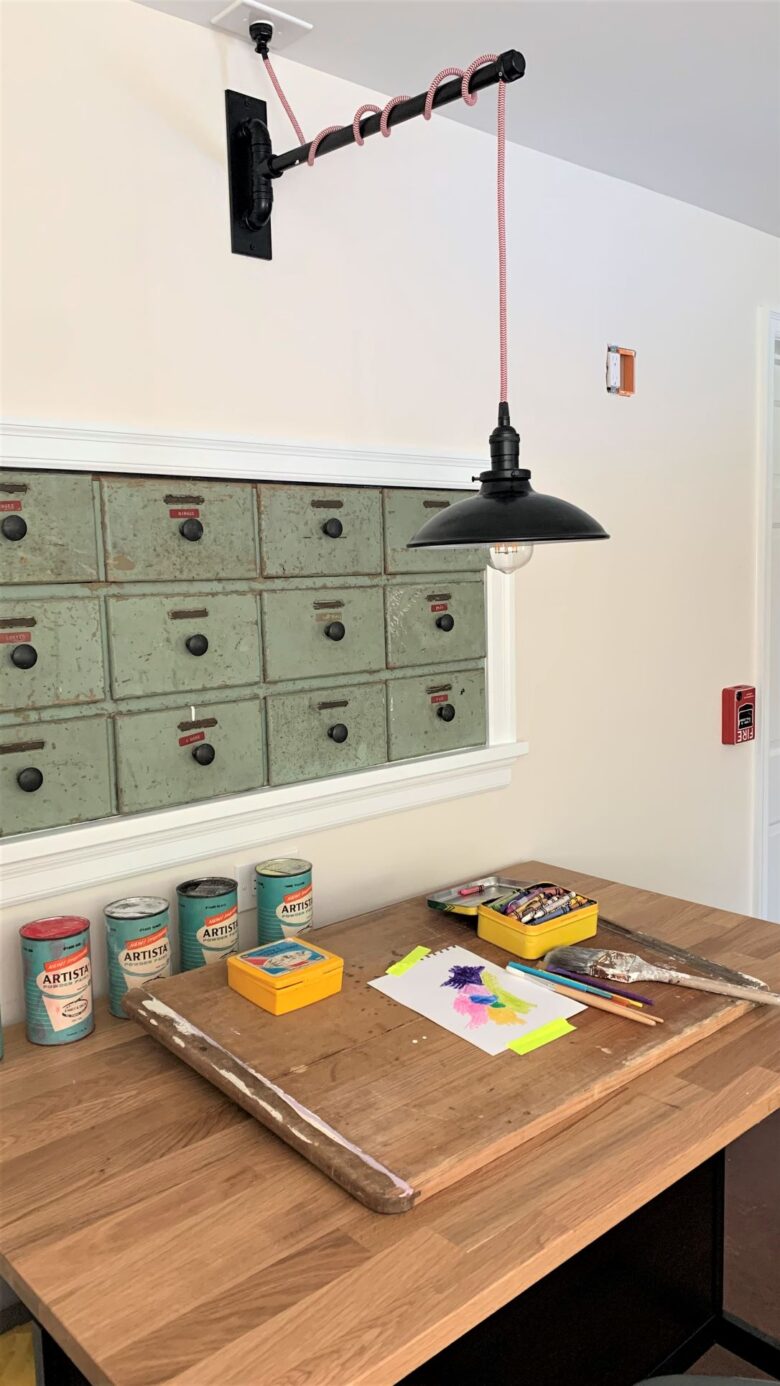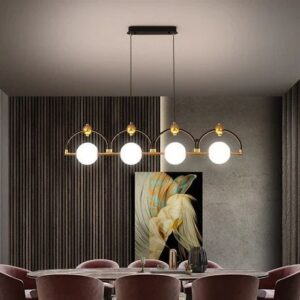Customizing is an art. Transform ordinary items into something extraordinary! With creativity and know-how, you can design your own unique lighting fixtures. Picture walking into a room lit by a beautiful chandelier you made yourself! DIY lighting solutions provide a chance to show your creativity and save money. Ideas like weaving string lights through wreaths or wrapping them around branches, and using different bulb types and colors are great ways to customize. Dimmer switches are also a great tool to adjust the brightness of the lights for any occasion. DIY lighting is truly enchanting!
Understanding the Importance of Lighting in Home Décor
To better understand the importance of lighting in home decor, dive into the section that explores the art of customization. Discover how to enhance your space with DIY lighting solutions, utilizing techniques like choosing the right light fixtures for your space and exploring various lighting techniques.
Choosing the Right Light Fixtures for Your Space
When it comes to lighting up your space, picking the right fixtures is paramount! Here’s 5 must-knows:
- Function: Understand what you need in each room, like task lighting for a home office or ambient lighting for a cozy living room, then pick a fixture that fits.
- Style: Choose fixtures that will enhance your home’s look. From modern to traditional, there’s something for every decor!
- Size: It’s important to get the size right – a tiny pendant won’t do in a large dining area, while an oversized chandelier can be too much in a small space.
- Position: Placement is key! Think about ceiling height, furniture & natural light when deciding where to install.
- Energy Efficiency: Pick energy-efficient fixtures that use minimal electricity and last longer. LED bulbs are a great choice.
Plus, more tips:
- Layer your lights for added depth and dimension.
- Use dimmer switches to alter intensity, depending on the activity or mood.
- Don’t forget outdoor lighting! Illuminate pathways, gardens & patio areas.
Before buying any fixture, measure your space carefully. Then, you’ll find the perfect light fixtures that’ll not only illuminate but also bring out the ambiance & functionality of your space.
Exploring Different Lighting Techniques
Let’s explore lighting techniques through a table. It’ll show their unique features and benefits.
| Lighting Technique | Description | Benefits |
|---|---|---|
| Accent Lighting | Highlights objects or areas, adding depth. | Enhances focal points, creates drama. |
| Ambient Lighting | Provides overall illumination, creating warm atmosphere. | Sets mood, ensures visibility in areas. |
| Task Lighting | Directs light to specific work areas. | Increases productivity, reduces eye strain. |
| Natural Lighting | Utilizes natural sunlight to brighten spaces. | Saves energy, promotes well-being. |
We must consider color temperature. Different bulbs emit various color temperatures. We must understand the impact it has on a room’s mood.
For example, a friend transformed their living room by incorporating dimmable LED lights behind wall-mounted shelves. It added sophistication and created a display for their collection.
By exploring lighting techniques and considering factors like color temperature, we can unlock the power of light in our homes. So go ahead, experiment, and watch as living spaces come alive.
Benefits of DIY Lighting Solutions
To enhance your knowledge of the benefits of DIY lighting solutions, dive into the world of cost-effectiveness and personalization. Discover how creating your own custom lighting can save you money while adding a unique touch to your home’s design. With these sub-sections, explore the financial and creative advantages of DIY lighting solutions.
Cost-Effectiveness of Creating Your Own Custom Lighting
Generating your own custom lights can be a cost-saving way to lighten up your area. With the right supplies and materials, you can save money and add an individual touch to your lighting design.
- By doing your own lighting, you can save on labor costs. Employing an expert to install or customize your lighting can be pricey. Instead, by doing the project yourself, you can cut down on these extra charges.
- Making your own custom lighting lets you re-use materials and items you already have. Upcycling old lamps or using house objects as light fixtures not only reduces waste but also saves you money on buying new lighting components.
- Lastly, DIY lighting projects usually give you the liberty to control your budget. You can choose affordable materials and adjust the complexity of your design according to your financial capacities.
In addition to these advantages, creating your own custom lighting also provides a singular chance for creativity and self-expression in designing your space’s atmosphere.
To demonstrate the benefits further: John, an interior design enthusiast from New York City, chose to make his own pendant lights for his living room. By using old wine bottles and transforming them into hanging fittings with LED lights, he not only saved money but also added a unique element of allure to his home décor.
Personalization and Uniqueness in Home Design
Personalizing and adding uniqueness to home design is important for creating a special living space. DIY lighting solutions are the way to go for infusing your home with a sense of individuality that reflects you!
Benefits of DIY lighting include:
- Customized design – you have control over the design, creating a unique look.
- Cost-effective – usually more affordable than store-bought.
- Flexible placement – pick where to install them to highlight certain areas.
- Energy-saving – components help reduce electricity costs.
- Pride – completing a DIY lighting project can give a great sense of satisfaction.
DIY lighting offers unique details that add charm and character to your home. For example, using vintage or repurposed materials for light fixtures creates an original look. Additionally, adjusting the intensity and color temperature of lights allows you to set the desired ambiance without limitations.
Let me share a story that shows the personalization and uniqueness achieved through DIY lighting. A couple wanted a romantic atmosphere, with soft, warm lighting in their bedroom. They created a chandelier out of mason jars and fairy lights, each jar filled with dried flowers. The result was not only the desired ambiance, but also a conversation starter with guests.
DIY lighting solutions can turn your home into a haven full of unique touches that match your style and personality. Don’t settle for generic options when you can create something extraordinary!
Getting Started with DIY Lighting Projects
To start getting started with DIY lighting projects, assess your space and lighting needs, and gather the necessary tools and materials. This section will guide you through the process of customization, helping you create personalized lighting solutions that align perfectly with your unique requirements.
Assessing Your Space and Lighting Needs
Starting any DIY lighting project requires a thorough assessment of your space. This will help you determine your specific lighting needs and design a setup that suits them. Here’s a 5-step guide:
- Functionality: Consider how the area will be used and what activities will take place there. This will guide your type and intensity of lighting.
- Natural light sources: Note any windows, skylights, or other light sources. This will help you optimize artificial lighting.
- Focal points: Look for artwork, architectural features, or furniture pieces. These may need specific accent or task lighting.
- Existing fixtures: Evaluate their placement and functionality. Consider rearranging or replacing them for a better fit.
- Energy efficiency: Think about energy-saving bulbs that can reduce electricity consumption while still providing illumination.
Tailor these steps to your particular environment. Remember that proper assessment leads to effective results. Experiment with different light sources and placements during the process. You may be amazed at how minor adjustments can completely change the atmosphere!
Gathering Necessary Tools and Materials
Gathering the necessary tools and materials for DIY lighting projects is essential. Here’s a guide to help you gather what you need:
- Identify project requirements: Figure out what lighting project you are planning, e.g. installing a fixture, creating a lamp, or adding LED strips. This will help you understand what is needed.
- Make a checklist: List all the tools and materials you need, such as screwdrivers, wire cutters, electrical tape, bulbs, wires, sockets, and switches. Having a checklist ensures you don’t miss anything.
- Research and source: Look online and at local stores for the best options that fit your budget and needs. Compare prices and read reviews before buying.
- Check out alternatives: See if there are any substitutes that can save money or offer design possibilities. But make sure they meet safety standards and won’t affect the project’s functionality.
Keep in mind safety and any special considerations related to your project.
DIY lighting projects have been around since ancient times. People have always looked for new ways to light up their spaces – from oil lamps to chandeliers. Now, with technology and materials being more accessible, DIY lighting projects are more popular than ever. People can show off their creativity with unique and personalized designs.
Step-by-Step Guide to Creating Custom Lighting
To create custom lighting in a step-by-step manner, equip yourself with the necessary solutions. With “Step-by-Step Guide to Creating Custom Lighting,” find inspiration and design ideas, select the right bulbs and lighting accessories, and successfully wire and install your light fixtures.
Finding Inspiration and Design Ideas
In the search for design ideas and inspiration, it is essential to explore different sources. Here are 3 key points to remember:
- Nature: Look at colors, textures, and patterns in the natural world for unique lighting designs.
- Architecture: Analyze how light interacts with space in great structures to unlock ideas.
- Art: View paintings, sculptures, and installations for creative concepts.
There are countless possibilities. Find new inspiration and make practical considerations for exceptional lighting designs.
Did you know Ingo Maurer said, “Light gives shape to spaces and determines our perception”? It shows light’s power to change environments and affect our experiences.
Selecting the Right Bulbs and Lighting Accessories
Choosing the appropriate bulbs and lighting accessories is essential for designing custom lighting. The right selection guarantees ideal luminosity, mood, and efficiency. Let’s take a look at some important components to mull over when choosing these elements.
To make a prudent choice, it’s necessary to be aware of the distinctive types of bulbs, their features, and their effect on lighting quality. Also, it’s wise to know the diverse lighting accessories on the market that can enhance the overall execution and outward appearance of your custom lighting system.
Check out this table which shows some important elements to take into account when selecting bulbs and lighting accessories:
| Bulb Type | Wattage | Color Temperature | Lifespan |
|---|---|---|---|
| Incandescent | 60W | 2700K | 1,000 hours |
| LED | 10W | 3000K | 25,000 hours |
| Halogen | 50W | 2900K | 1,500 hours |
| Fluorescent | 15W | 3500K | 10,000 hours |
Aside from picking the correct bulb type and wattage for your demands, thinking about color temperature is also crucial. Different color temperatures yield different moods – warm tones (below 3000K) present an intimate feeling, while cool colors (above 5000K) are stimulating and centered. The durability of a bulb is worth evaluating as it decides future maintenance costs.
Pro Tip: When selecting bulbs and lighting accessories, always check if they work together to guarantee optimal performance and functioning in your customized lighting setup.
Wiring and Installing Your Light Fixtures
Create custom lighting in your space by wiring and installing your own light fixtures. Here’s how:
1. Prepare the wiring: First, cut off the power supply to the area. Double-check with a voltage tester. Then, remove any old fixtures. Clean the area before continuing.
2. Connect the wires: Identify the hot (black), neutral (white), and ground (green/bare copper) wires. Strip off ½ inch of insulation, twist together the matching colors, and secure with wire nuts. Make sure all connections are tight.
3. Install the fixture: Carefully mount the light fixture onto the designated location. Use the screws or hardware included. When done, turn the power back on and test.
| Remember: |
| – Insulate connections with electrical tape. |
| – Seek professional help for complex wiring. |
| – Don’t overload circuits. |
| – Prioritize safety. |
By following these steps, you can wire and install custom light fixtures safely. This will add beauty to your space while providing illumination.
Safety Precautions and Tips for DIY Lighting Projects
To ensure your safety and success in DIY lighting projects, equip yourself with valuable knowledge and practices. Understand electrical wiring and codes and master proper handling and installation techniques. These sub-sections offer solutions for a secure and effective execution of your customized lighting solutions.
Understanding Electrical Wiring and Codes
Gorgeous lighting projects are as alluring as they appear. So, what makes them doable? Knowing wiring and codes is key for ensuring safety and the right functioning of these DIY lighting projects.
But how to understand wiring and codes without getting overwhelmed or risking any disasters? Here are some vital facts to be aware of:
- Safety regulations: Get familiar with safety regulations, such as grounding and circuit protection, to avoid any dangers.
- Wire types: Different wires have different uses. Know the correct wire type for your project to avoid short circuits or overheating.
- Outlet installation: Learn proper installation techniques of outlets to guarantee they are secure, effective, and meet electrical codes.
- Circuit breaker panel: Know how a circuit breaker panel works and learn to spot and reset tripped breakers in an emergency.
Plus, here are some extra details to keep in mind:
- Labeling wires: Always label your wires during installation for easy recognition later.
- Local codes: Check local electrical codes as they may vary from one area to another.
- Grounding: Properly ground your lighting project for avoiding electric shocks.
Now that you have all the vital knowledge, don’t let the fear of missing out stop you! Go ahead and try DIY lighting projects with assurance, equipped with a fresh understanding of wiring and codes. Start creating marvelous lighting settings that will light up your space with brilliance!
Proper Handling and Installation Techniques
DIY lighting projects require the right handling and installation techniques for safety and successful results. Here are 3 steps to follow:
| 1. Get the right tools – This includes wire cutters, pliers, screwdrivers and a voltage tester. Using the right tools helps avoid accidents. |
| 2. Power off – Before handling any lighting fixtures or wires, make sure to turn off the power source at the circuit breaker. This is to avoid electric shocks. |
| 3. Secure connections – Connections must be tight and secure. Loose connections can cause faulty wiring and fire hazards. Use electrical tape or wire connectors to do this. |
Refer to manufacturer instructions for further guidelines. Experienced DIYers must exercise caution and follow safety guidelines when dealing with electricity.
History shows us that proper handling and installation techniques for DIY lighting projects have improved over time. Earlier, safety regulations were few and accidents and faulty installations were more common. But, now, technology and awareness of electrical safety has increased standards to safeguard homeowners and promote safe practices in DIY projects. It is vital to stay up-to-date with regulations and guidelines to ensure safety for yourself and your home during any lighting project.
Troubleshooting and Maintenance of DIY Lighting Solutions
To troubleshoot and maintain your DIY lighting solutions effectively, equip yourself with the knowledge of common issues and their solutions. Additionally, learn the essential techniques for cleaning and maintaining your DIY lighting fixtures. With these sub-sections, you’ll be equipped to handle any problems and keep your customized lighting in top condition.
Common Issues and How to Fix Them
Having issues with DIY lighting? Fear not! Follow this step-by-step guide and get it sorted.
- Check the power source. Make sure the fixture is connected to a working outlet. If it’s plugged in but still not working, try another outlet or check the circuit breaker.
- Examine the bulbs. The problem could be with them. Look for loose connections or damage. If needed, replace them with new compatible ones.
- Inspect the wiring. Flickering lights or no lights at all could mean faulty wiring. Look for exposed or frayed areas. If you find damage, hire a pro to repair or replace.
- Position dimmers and switches correctly. Wrongly placed dimmer switches lead to flickering lights or inconsistent brightness. Install them as per instructions and check they’re compatible.
Unique details:
- Handle electricity with caution and turn off power before making adjustments.
- Use surge protectors or voltage regulators to prevent damage from electrical fluctuations.
- When using LEDs, make sure they’re dimmable-rated if you plan on using dimmer switches.
Example:
My friend installed pendant lights in his kitchen. One light kept flickering. After following troubleshooting steps and replacing incompatible dimmer switches, the issue was solved. His kitchen now looks great with beautiful, uninterrupted lighting.
With some patience, you can troubleshoot and fix DIY lighting issues!
Cleaning and Maintaining Your DIY Lighting Fixtures
It’s key to clean and maintain your DIY lighting fixtures for optimal performance and long life. Not doing this can lead to dimness, flickers, and even safety risks. Here’s a guide on how to clean and maintain them effectively:
- Look for Dust and Dirt: Check your lighting fixtures often for dust and dirt build-up. This reduces light brightness and makes them look bad. Use a soft cloth or feather duster to gently remove the dust.
- Clean with Soap Solution: If dirt or stains won’t come off, use a mild soap solution. Mix some liquid soap with warm water. Use a cloth or sponge to carefully wipe the fixture. Avoid too much moisture – it can damage it.
- Check Connections: It’s also important to inspect the electrical connections of your DIY lighting fixtures. Loose ones can make lights flicker or not work. Turn off the power before checking. Make sure all connections are secure.
Here are more tips to help you maintain your DIY lighting fixtures:
- Replace burnt-out bulbs quickly to stop stressing other components.
- Use LED bulbs for energy efficiency.
- Use dimmer switches or timers for extra features.
- Keep spare parts ready for fast replacements.
Cleaning and maintaining your DIY lighting fixtures helps their looks and life. Following these steps will ensure they efficiently light up your space while keeping risks low. Don’t miss out on your chance to get a good-looking, bright ambiance – start taking care of your fixtures now!
Conclusion
We’ve discussed DIY lighting solutions: customization is key for personalization. By trying different approaches and materials, you can make lighting fixtures that light up your space and add unique flair.
Unconventional objects can be used as light sources. For example, mason jars and wine bottles can become pendant lights, creating a rustic vibe and being sustainable by reusing.
Adjustable elements give flexibility in design. With dimmer switches or smart bulbs, you can create the perfect atmosphere for any occasion.
Also, experiment with light bulbs. LED bulbs are energy-efficient and come in different colors. Edison bulbs emit a warm vintage glow, adding a nostalgic touch.
Frequently Asked Questions
FAQ 1:
Q: What are DIY lighting solutions?
A: DIY lighting solutions refer to the practice of customizing and creating your own lighting fixtures and designs using various materials and techniques, instead of buying pre-made lighting products.
FAQ 2:
Q: Why should I consider DIY lighting solutions?
A: DIY lighting solutions provide a unique opportunity to personalize your space and create lighting fixtures that perfectly match your style and preferences. It can also be a cost-effective way to have high-quality lighting without spending a fortune.
FAQ 3:
Q: What materials can be used for DIY lighting projects?
A: DIY lighting projects can be done using a wide range of materials such as reclaimed wood, metal pipes, mason jars, fabric, paper, and even recycled materials. The choice of materials depends on the design and style you want to achieve.
FAQ 4:
Q: Do I need special skills to create DIY lighting solutions?
A: While some DIY lighting projects require advanced skills and knowledge of electrical wiring, there are plenty of projects suitable for beginners. It’s always important to follow safety guidelines and seek professional help for complex projects if you are unsure.
FAQ 5:
Q: Where can I find inspiration for DIY lighting solutions?
A: Inspiration for DIY lighting solutions can be found in various sources such as online platforms like Pinterest and DIY blogs, interior design magazines, and even by exploring lighting designs in stores. You can also get creative by repurposing everyday objects into unique lighting fixtures.
FAQ 6:
Q: Are there any safety considerations when working with DIY lighting solutions?
A: Yes, safety is paramount when working with DIY lighting solutions. Always ensure proper electrical connections, use the correct wattage bulbs, and follow any building codes or regulations regarding electrical work. If you are unsure or uncomfortable, it’s best to consult a professional electrician.



